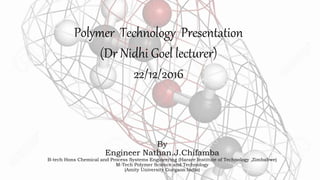polyvinylacetate.pdf
- 1. By Engineer Nathan.J.Chifamba B-tech Hons Chemical and Process Systems Engineering (Harare Institute of Technology ,Zimbabwe) M-Tech Polymer Science and Technology (Amity University Gurgaon India) Polymer Technology Presentation (Dr Nidhi Goel lecturer) 22/12/2016
- 3. Brief History âĒ Poly(vinyl acetate) was discovered in Germany in 1912 by Fritz Klatte. âĒ The monomer, vinyl acetate, was first produced on an industrial scale by addition of acetic acid to acetylene with a mercury(I) salt but it is now primarily made by palladium catalyzed oxidative addition of acetic acid to ethylene. âĒ Polyvinyl acetate is prepared by polymerization of vinyl acetate monomer (free radical vinyl polymerization of the monomer vinyl acetate).
- 4. INTRODUCTION âĒ it is a colorless, nontoxic thermoplastic resin prepared by the polymerization of vinyl acetate. Polyvinyl acetate (PVAC) It is one of the most widely used water-dispersed resins. âĒ Polyvinyl acetate water-based emulsions have been used as latex house paints, artists' media (since 1945), and common household white glues.. âĒ Poly(vinyl acetate) (PVA, PVAc, poly(ethenyl ethanoate) âĒ It is commonly referred to as wood glue, white glue, carpenter's glue, school glue, Elmer's glue in the US, or PVA glue) âĒ It is an aliphatic rubbery synthetic polymer with the formula (C4H6O2)n. It belongs to the polyvinyl esters family with the general formula - [RCOOCHCH2]-.
- 5. PROPERTIES ïžUnder alkaline conditions, boron compounds such as boric acid or borax cause the polymer to cross-link. ïžA number of microorganisms can degrade polyvinyl acetate(fungi and algae). ïžSets by the removal of water due to evaporation or absorption into a substrate. ïž Have good weather resistance ïžWithstand water, grease, oil, and petroleum fuels degradation. ïžgood biodegradation resistance ïžpoor resistance to creep under load. ïžSoftens at 30-45C ïžSoluble in benzene, chloroform, methanol, acetone, butyl acetate ïžInsoluble in ligroin, diethyl ether, butanol, turpentine, water, oils ïžCan absorb 3-5% water when immersed for 16 hours at 60 C. ïžBurns with a dark yellow flame that smells of acetic acid. ïžCombustible.
- 6. Uses âĒ PVA water-based emulsions have been used as latex house paints. âĒ Making commonly used household white glues. âĒ Making wood glue. âĒ Makin paper glue. âĒ Adhesives. âĒ Glues for porous material. âĒ Used as a primer for drywall and other substrates. âĒ As a mortar additive.
- 7. 7 Mechanism (free radical Polymerization)



![INTRODUCTION
âĒ it is a colorless, nontoxic thermoplastic resin prepared by the
polymerization of vinyl acetate. Polyvinyl acetate (PVAC) It is one of
the most widely used water-dispersed resins.
âĒ Polyvinyl acetate water-based emulsions have been used as latex
house paints, artists' media (since 1945), and common household
white glues..
âĒ Poly(vinyl acetate) (PVA, PVAc, poly(ethenyl ethanoate)
âĒ It is commonly referred to as wood glue, white glue, carpenter's glue,
school glue, Elmer's glue in the US, or PVA glue)
âĒ It is an aliphatic rubbery synthetic polymer with the formula (C4H6O2)n.
It belongs to the polyvinyl esters family with the general formula -
[RCOOCHCH2]-.](https://image.slidesharecdn.com/polyvinylacetate-161221161744-230214135309-85920174/85/polyvinylacetate-pdf-4-320.jpg)






